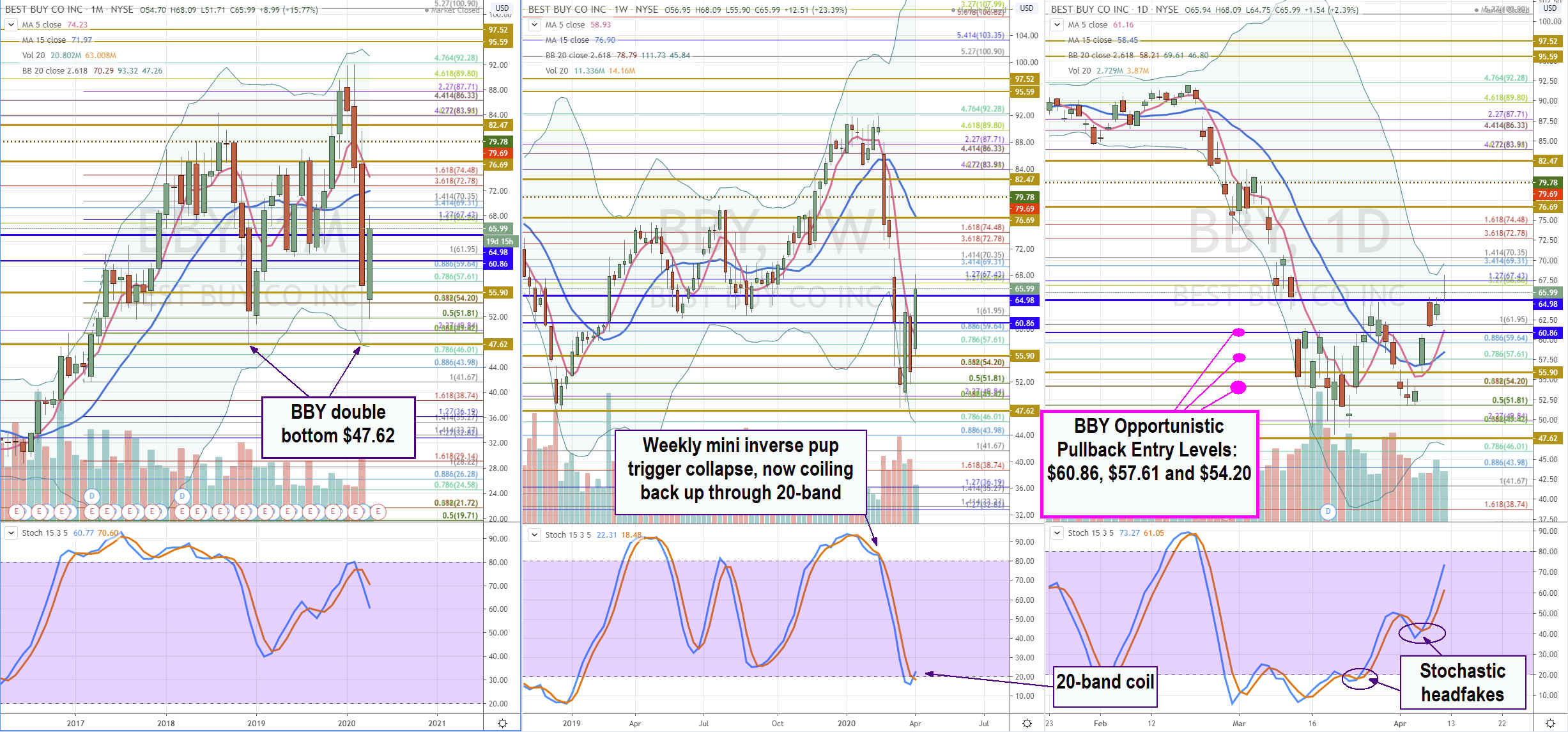Consumer electronics retailer
Best Buy (NYSE: BBY) shares have been a livewire that continues to react in a bipolar manner. Standalone brick and mortar retailers have had mixed sentiment often reacting as a hedge in down market moves. Stocks like
Costco Wholesale (NASDAQ: COST) ,
Target (NYSE: TGT) ,
Walmart (NYSE: WMT) ,
Kroger’s (NYSE:KR) have remained resilient due to the spike in demand for essential goods and stockpiling. Best Buy is the largest electronics retailer and experiencing heavy demand offset by store closures and conversions to curbside service. Shares still maintain positive correlation with the
S&P 500 (NYSEARCA: SPY). While shares have rebound off recent lows, prudent investors should be aware of these entry price levels that make BBY a bargain.
Pre-Pandemic Q4 2020 Earnings Results
On Feb. 27, 2020, Best Buy released Q4 2020 earnings ending Feb. 1, 2020. Revenues came in at $15.2 billion vs. $15.05 billion consensus analyst estimates indicating 2.7% year-over-year (YoY) growth. Earnings came in a $2.90-per share beating analyst estimates by + 0.14-per share. The company raised its dividend to $0.55-per share, up 10%. Enterprise comparable sales rose +3.2%. Best Buy raised FY 2021 EPS guidance to $6.10 to $6.30 versus $6.03 analyst estimates. FY 2021 revenue estimates were lowered to a range of $43.3 to $44.03 billion versus $44.03 consensus analyst estimates. Enterprise comparable FY 2021 sales growth will be flat to 2%. The timing of the release during the coronavirus market sell-off compounded downside momentum as shares plunged (-48%) off its highs of $91.99 on Feb. 20th to lows of $48.11 by March 19th.
March Pandemic Update
On Mar. 21st, Best Buy updated investors in a press release stating that quarter-to-date demand had exceeded expectations due to social distancing mandates that relegated people to learn and work from home. However, the company pulled all FY 2021 guidance due to the uncertainty of COVID-19. They also tapped their full $1.25 billion revolving credit facility on March 19th to maximize liquidity in addition to the $2 billion of cash and cash equivalents on hand.
COVID-19 Bolsters Curbside Service
Best Buy is a standalone brick and mortar retailer but due to the self-isolation mandates prompting over 100 million people to connect remotely demand for computer products and accessories have surged. As of March 22nd, all retail stores have been converted to enhanced curbside pickup only, where orders can be made online or through the Best Buy app. In-home product installations and repairs have been suspended due to COVID-19, but n-home consultations are being conducted virtually.
Reinforcing Christmas 2019 Template Boosting App Engagement
It almost smells of déjà vu during Christmas 2019 when Amazon (NASDAQ: AMZN) placed shipping restrictions with FedEx (NYSE: FDX) just over week before Christmas. This caused nervous consumers to swarm brick and mortar stores to pick up their Christmas presents rather than risk shipping delays. The template of order online and pick at the store, or curbside, helped boost Best Buy revenues and should repeat on a larger scale this time. Best Buy reported their app usage was up 22% in fiscal 2020. App users engaged 8X more frequently than those who solely access the website or mobile site. Store pickups rose to 42% of online sales in Q4 which grew 18.7% YoY representing 20% of total domestic revenue.

Opportunistic Buy Levels
Using the rifle charts on wider time frames to lay out the playing field is suitable for swing traders and investors. The monthly BBY stochastic rejected off the 80-band as BBY collapsed to the monthly lower Bollinger Bands (BBs) near $47.62, which was also the lows of December 2018 making a double bottom. BBY shares completed a full oscillation down and commenced a coil back up through the 20-band on the weekly stochastic after triggering a market structure low (MSL) above $64.99. The weekly 5-period moving average (MA) support sits at $58.93. The daily stochastic has been in a choppy grind after crossing down twice. Each of these cross downs sucked in short-sellers that got squeezed on the stochastic crossovers back up. The daily MSL trigger formed above $60.86 which overlaps with the daily 5-pd MA support. The daily upper BBs overlap with the $69.31 Fibonacci (fib) level. With this set-up, a climactic peak at the daily upper BBs or a pullback to the daily 5-pd MA is in the cards. Prudent investors and traders will want to wait for pullbacks to consider opportunistic entry levels. These are the three opportunistic entry levels: $60.86 daily MSL, $57.61 fib and $54.20 overlapped fibs. Nimble traders can scalp these levels initially for reversion and then with the intraday trend. Swing traders can scale for overnight to multi-day holds. Long-term investors may consider a dollar-cost averaging approach with income generation through writing covered calls.
Before you make your next trade, you'll want to hear this.
MarketBeat keeps track of Wall Street's top-rated and best performing research analysts and the stocks they recommend to their clients on a daily basis.
Our team has identified the five stocks that top analysts are quietly whispering to their clients to buy now before the broader market catches on... and none of the big name stocks were on the list.
They believe these five stocks are the five best companies for investors to buy now...
See The Five Stocks Here
Enter your email address and we'll send you MarketBeat's list of ten stocks that are set to soar in Spring 2025, despite the threat of tariffs and other economic uncertainty. These ten stocks are incredibly resilient and are likely to thrive in any economic environment.
Get This Free Report
Like this article? Share it with a colleague.
Link copied to clipboard.